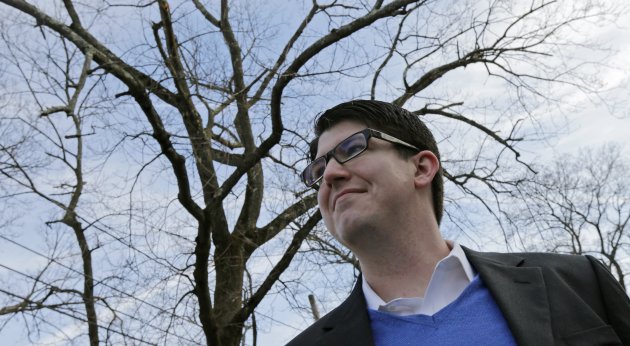In 1784, residents of western North Carolina, feeling isolated by the mountains
surrounding them, formed their own independent state.
On
a frigid afternoon in February 1788, Col. John Sevier, a Revolutionary
War hero and political leader in the mountains of western North
Carolina, spurred his horse toward a farm on the banks of a stream
called Sinking Creek.
With him were more than 100 armed men. As they reached the homestead,
Sevier ordered them to fan out and encircle the house. Inside, Col.
John Tipton, another prominent Revolutionary War veteran, watched the
force surround his home. Trapped with him were his family and his own
group of armed men — but, far outnumbered, they were too few to break
through Sevier’s lines.
The two sides locked into a siege, muskets trained on one another
across the frozen ground. Demands for surrender passed both ways, but
all were rebuffed. The standoff would end only with the roar of gunfire.
The siege on Sinking Creek brought to a climax a strange and
little-remembered episode in our state’s history. Sevier and Tipton,
former compatriots in the war against the British, were now implacable
foes, the principal adversaries in the struggle over an enclave carved
out of northwestern North Carolina that its supporters sought to make
the new nation’s 14th state — “the lost state” of Franklin.
Tipping point
After the smoke of the Revolutionary War had cleared and the
giddiness of newly won independence had faded, North Carolina faced
numerous challenges, not the least of which was crushing debt. One
partial solution was to cede the western part of the state — which ran
all the way to the Mississippi River — to the federal government. The
state legislature (many of whose members, not coincidentally, stood to
gain financially from the transaction) voted in the spring of 1784 to
cede the land west of the Appalachians to the United States. The action
proved the tipping point for many of the residents of the remote region.
Independent by nature and separated from the rest of the state by the
nearly impassable mountains, many felt they were North Carolinians in
name only, and that the costs — that is, taxes — of being within the
state outstripped the benefits.
Some were calling to establish an independent state that could
provide the region better services and stouter protection in conflicts
with the Cherokee. When North Carolina cut the region free by ceding it
to the federal government, supporters of statehood seized the
opportunity to determine their own destiny.
In August 1784, a gathering of prominent residents, including Sevier
and Tipton, met in the town of Jonesborough and voted to begin the
process of creating a free and independent state.
The effort nearly failed before it was born when the North Carolina
legislature, its balance of power altered in recent elections, reversed
course and repealed the Cession Act, again claiming dominion over its
western lands. North Carolina had no intention of letting the rough-hewn
mountain counties go their own way.
But once lit, the fires of independence were not easily doused. The
leaders of the breakaway region met again in December 1784 and, after
strenuous debate, voted to establish the new state. They named the new
entity Franklin, in honor of Benjamin Franklin (although some called it
the similar-sounding “Frankland,” which meant, through a bit of a
linguistic stretch, “Land of the Free”). Sevier, the most prominent of
the delegates, initially opposed the statehood movement. A descendant of
the French Huguenots, he rose to prominence as an American Indian
fighter, political leader, and hero of the Revolutionary War battle at
Kings Mountain.
But Sevier was soon persuaded of the rightness of independence, and,
in early 1785, Franklin’s delegates elected him to be its first — and
only — governor. Once committed, Sevier took to the cause with fervor.
Sentiment for statehood was by no means unanimous, especially after
North Carolina’s repeal of cession, and Franklin’s declaration of
independence split the region into two factions. As Sevier took up the
standard for statehood, Tipton rose to lead the opposition.
Like Sevier, Tipton was a well-known veteran and political leader,
and he, too, changed sides early in the debate over the new state,
transforming from initial support to fierce opposition.
Convinced that the repeal of cession rendered independent statehood
moot, Tipton offered his services to North Carolina. The mother state
accepted, and he set himself on a mission to destroy Franklin and return
the region to the state’s fold.
Meanwhile, Franklin set about the heady business of independence.
Under Governor Sevier, the fledgling state held elections, established a
legislature, and adopted a constitution (after rejecting an earlier
version that would have been truly revolutionary — it would have barred
lawyers, among others, from being elected to public office). Franklin
established a judicial system, set taxes, annexed land, incorporated new
counties, and made treaties with the Cherokee.
Parallel governments
Back east, the North Carolina government did not look kindly upon
these developments. Gov. Alexander Martin warned Franklin’s leaders to
end their “revolt” and acquiesce to the authority of the mother state.
Nevertheless, the state declined to send troops across the mountains
to enforce its rule. The state instead exerted its authority by
establishing its own legislative, judicial, and economic systems within
the region.
The result was a bizarre arrangement of parallel governments. In any
given settlement there was likely to be a Franklin court and a North
Carolina court, a Franklin sheriff and a North Carolina sheriff, a
Franklin justice of the peace and a North Carolina justice of the peace.
Small wonder that residents felt divided. To which state did they owe
their allegiance, not to mention their tax dollars? To which courthouse
should they go to get married or file a land deed?
The competing bureaucracies exacerbated rising tensions between the
Franklinites and the Tiptonites, as the state’s opponents were called.
The political differences between Sevier and Tipton hardened into a
bitter personal feud, and the rift between the two factions grew wider
and more adversarial. Tipton led raids on Franklin courthouses, seizing
court papers and booting out judges; Sevier and his supporters
retaliated in kind. On one occasion, their rivalry erupted in
fisticuffs, and the two leaders brawled until they were pulled apart.
At the same time, a war of correspondence and speech was under way,
as Franklin appealed to North Carolina to let it go in peace, and North
Carolina sought to reclaim the region without bloodshed, offering
amnesty and other incentives if Franklin would abandon its quixotic
quest.
Franklin sought support from all quarters, including a peculiar
dalliance with Spain. Everywhere it was disappointed. Its petition to
Congress seeking admission as the country’s 14th state fell short of the
two-thirds majority needed. The state’s namesake, Benjamin Franklin,
declined to offer his blessing, as did Thomas Jefferson. If it
succeeded, Jefferson wrote, “Our states will crumble into atoms by the
spirit of establishing every little canton into a separate state.”
Franklin was in limbo, able to count on security and assistance from
neither North Carolina nor the United States. Alone and wrought by
internal divisions, the new state found its never-solid foundations
growing increasingly wobbly. Political turmoil, bloody clashes with the
Cherokee, and the failure to win external support threatened to bring
Franklin crashing down.
Final collapse
The crisis came to a head in February 1788. Tipton, determined to
bring Sevier to heel, ordered Sheriff Jonathan Pugh to seize Sevier’s
slaves and livestock as payment for taxes owed to North Carolina. He had
Pugh secure the seized assets at Tipton’s own homestead.
Sevier was preparing to lead an expedition against the Cherokee when
he got wind of what had happened. He immediately led his force of
Franklin militia to Tipton’s farm and surrounded it.
For two days the sides faced each other, frozen in stalemate, until
February 29, when a large party of Tiptonite militia from Sullivan
County rode to rescue the besieged leader. They pitched into the outer
ring of Sevier’s troops, and Tipton and his men broke from the homestead
and launched a supporting attack. Sevier’s command crumbled, and his
men fled.
Several men, including Pugh, died in the fight, and several others
were injured. Tipton captured two of Sevier’s sons and threatened to
hang them before cooler heads prevailed.
Sevier escaped, but a warrant for his arrest for treason was issued.
In November 1788, Tipton caught up with him in Jonesborough and arrested
him.
Upon Sevier’s defeat, the state he led finally collapsed. It took
awhile for the last few embers of independence to die out, but by 1789
the rebellious region was once again firmly under North Carolina’s
control.
In the aftermath, North Carolina showed leniency. Sevier was pardoned
and soon was elected to the legislature to represent the very region he
had led in secession.
North Carolina again ceded the western territory to the United
States, and in 1796 the counties that had formed the state of Franklin,
along with the lands stretching westward to the Mississippi, finally
were admitted to the Union as an independent state — Tennessee.
The victor in the struggle over Franklin, John Tipton, was
subsequently elected a state senator in Tennessee. The new state’s first
governor? John Sevier.


























